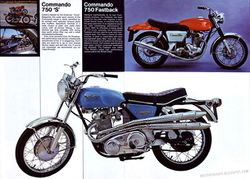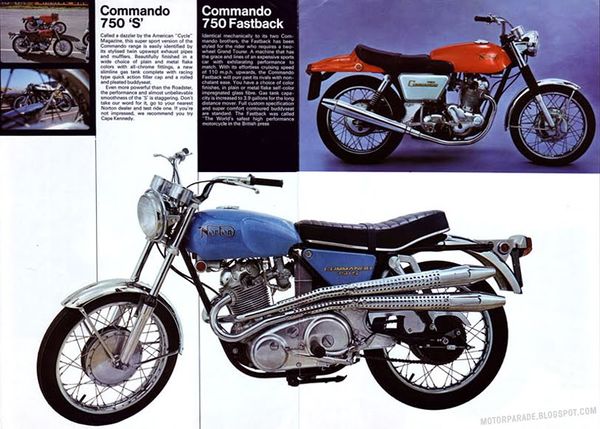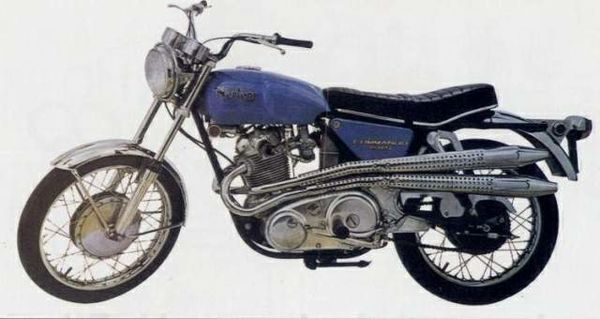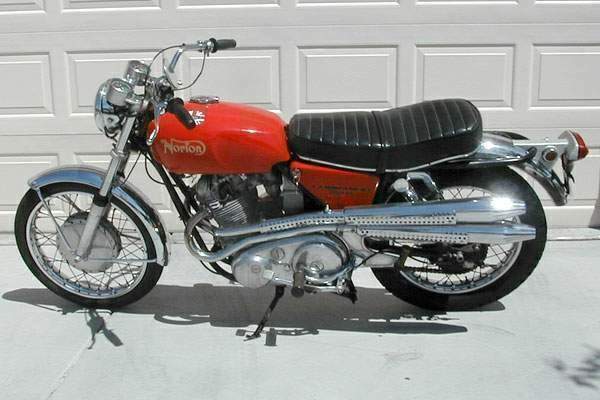Norton Commando 750S Scrambler
 |
|
| Norton Commando 750S Scrambler | |
| Manufacturer | |
|---|---|
| Production | 1969 - 70 |
| Engine | Four stroke, parallel twin cylinder, push rod 2 valves per cylinder. |
| Compression ratio | 9.0:1 |
| Top Speed | 185 km/h / 115 mph |
| Transmission | 4 Speed |
| Suspension | Front: Telescopic forks Rear: Dual shocks, 5-way adjustable |
| Brakes | Front: Ø203 mm Drum Rear: Ø178 mm Drum |
| Front Tire | 3.25-19 |
| Rear Tire | 4.00-18 |
| Weight | 191 kg / 421 lbs (dry), |
| Fuel Capacity | 10 Liters / 2.6 US gal |
| Manuals | Service Manual |
It could reach a top speed of 185 km/h / 115 mph.
Engine[edit | edit source]
The engine was a Air cooled cooled Four stroke, parallel twin cylinder, push rod 2 valves per cylinder.. The engine featured a 9.0:1 compression ratio.
Chassis[edit | edit source]
It came with a 3.25-19 front tire and a 4.00-18 rear tire. Stopping was achieved via Ø203 mm Drum in the front and a Ø178 mm Drum in the rear. The front suspension was a Telescopic forks while the rear was equipped with a Dual shocks, 5-way adjustable. The Commando 750S Scrambler was fitted with a 10 Liters / 2.6 US gal fuel tank. The bike weighed just 191 kg / 421 lbs.
Photos[edit | edit source]
Overview[edit | edit source]
Norton Commando 750S Scrambler
Test
My ride on the bright yellow Commando had not started well. The big
twin-cylinder engine had required several leaps on the kickstarter before
finally bursting into life. The front drum brake's
new shoes had needed bedding-in before working properly, and when I'd finally
reached the open road and wound open the throttle, the clutch had started
slipping as soon as the engine began to work hard.
But what a difference a few hours' riding made! Starting my final ride, the
Norton motor fired-up first time in response to my practiced leap on the lever,
emitting a deep bellow through the side-by-side pipes. As I reluctantly rode
back to return the bike to its owner, the front brake was working much better
and the clutch was fine, even when the motor's mighty midrange acceleration was
used to the full.
Falling in love with a motorbike is dangerously easy when it's as pretty and
distinctive as this yellow Norton. Few bikes are more interesting from the left
side than the right, but the Commando S, which was built for only a short time
in 1969 and 1970, is one of them. Those twin high-level pipes, beautifully set
off by perforated heat shields, combine with the high handlebars' and compact
tank and engine unit to give a timeless appeal.
Norton had introduced the Commando, with conventional lower pipes on each
side, back in ApriJ 1968. The Birmingham firm's parallel twin lineage stretched
back to the 500cc Dominator of 1949, and the new model was a big hit from the
word go. Its angled-forward 746cc engine, based on the same-size Atlas unit,
thundered out an increased output of 58 BHP at 6400 RPM, and incorporated mods
including higher compression, a bigger alternator, triplex instead of single-row
primary chain, plus a car-style clutch with four plates and a single diaphragm
spring.
It was partly to satisfy the American export market, where Atlas-based desert
bikes were popular and many machines were offered with high-level pipes, that
Norton introduced the Commando 750S in March 1969. In addtion to its high bars
and pipes, the S also had a smaller fiberglass gas tank, which it. shared with
the year's other new model, the more conventional Commando R. Both models had a
revised Mk II engine with new ignition points and revised rev-counter drive.
Slightly increased compression ratio of 9:1, combined with the free-breathing
reverse-cone pipes, increased peak output to 60 BHP.
Norton retained the ingenious Isolastic system that had already become an
important part of the Commando's appeal. The frame's main large-diameter steel
spine held a cradle of smaller-diameter tubes that supported the engine/gearbox
unit, the shakings of which were isolated from the rider by the Isolastic
system's trio of rubber mounts. Other changes included exposed (instead of
gaitered) forks and a conventional seat instead of the original Fastback item.
Extra chrome on details, including mudguard stays and gearlever, added to the
flamboyant image.
At some stage this bike's motor had been replaced by the bored-out, 829cc
motor that Norton introduced to power the 850 Commando in 1973. Purists would
doubtless be horrified by this and several other later-model parts, including
the front fender and speedometer. But this Commando lost nothing in my eyes by
having the softer, torquier, and generally more oil-tight 850 motor, for which
Norton initially claimed an identical 60 BHP peak output.
In typical Commando fashion, this bike needed a fierce lunge at the
kick-start to turn it over. But if started correctly, it always fired-up in a
couple of kicks. Once the clutch-slipa typical result of its recent
inactivityhad cleared, the motor was wonderful, pulling from very low revs with
an eager throttle response made more thrilling by the hung-out-to-dry riding
position and guttural exhaust growl.
There was too much traffic around to get close to the Norton's likely top
speed of about 115 mph (185 km/h), but it surged toward the ton mark
enthusiastically. More to the point, the Commando was happy to cruise at an
indicated 80 mph (130 km/h) for as long as I cared to hold on to those high
bars. Its four-speed gearchange was impressively precise, too. There was a
little bit of vibration through seat and footrests, despite the Isolastics. But
the Commando was smooth enough to make me realize how much of an edge the system
must have given over rival parallel twins, if not over Honda's recently released
CB750-four.
Its chassis was also good enough to maintain Norton's reputation for fine
handling. Despite the high bars, the Commando was stable at speed. And although
its steering wasn't exactly quick, due to old-style geometry and 19-inch wheels,
the 185 kg (407 lb) bike felt reasonably light and flickable. Suspension was
fairly firm, especially at the rear, which helped handling but gave a slightly
harsh ride over bigger bumps.
Back in 1970 the 750S was less popular than its conventional siblings, and it
was soon dropped (although a similarly styled, and even shorter-lived, 750SS
model was produced in the following year). With its high bars and tiny tank,
this was far from the most practical Norton ever made. But if it's style,
torque, handling, and charisma you're after, the Commando 750S has got the lot.
From Motorcyclist, Aug.1969
"Now comes the second generation Commando, the S model aimed straight at the
sporting rider who wants top performance allied to good looks and does not mind
paying for it.
It had that Norton feeltaut and responsive, with real power coming from low,
low down the rev range. This wide spread of power made the Commando S easy to
ride. You could trickle along atYiear walking pace, crack open the throttle and
away you'd go with the exhaust note rising to a pleasant crescendo behind you.
Top speed is well into the 120 zone, with 100 mph coring up in a rush in
third. Of course, the joy of it all is that it is done without vibration, the
curse of so many otherwise good bikes. Yes, the Commando S is the best Norton
yet, and one which will win many new friends for the famous name which goes
right back to 1907, when a Norton won the twin cylinder class of the very first
Isle of Man TT."
Source Superbike of the seventies
| Make Model | Norton Commando 750S Scrambler |
|---|---|
| Year | 1969 - 70 |
| Engine Type | Four stroke, parallel twin cylinder, push rod 2 valves per cylinder. |
| Displacement | 745 cc / 45.5 cu in |
| Bore X Stroke | 73 x 89 mm |
| Compression | 9.0:1 |
| Cooling System | Air cooled |
| Exhaust | 2-into-2, Chrome |
| Induction | 2 x Ø30 mm Amal concentric carburetors |
| Starting | Kick |
| Max Power | 58 hp / 43 kW @ 6800 rpm |
| Transmission | 4 Speed |
| Final Drive | Chain |
| Front Suspension | Telescopic forks |
| Rear Suspension | Dual shocks, 5-way adjustable |
| Front Brakes | Ø203 mm Drum |
| Rear Brakes | Ø178 mm Drum |
| Front Tire | 3.25-19 |
| Rear Tire | 4.00-18 |
| Dry Weight | 191 kg / 421 lbs |
| Fuel Capacity | 10 Liters / 2.6 US gal |
| Top Speed | 185 km/h / 115 mph |


